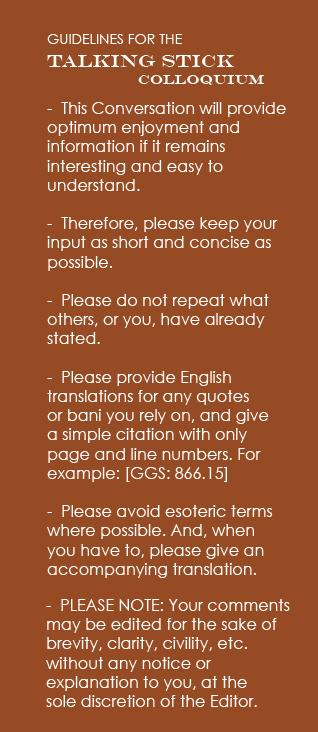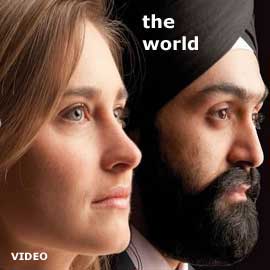Columnists
Kirtan Sohila
The Talking Stick Collquium XXIII, Stanza Three, June 7-13
Convenor: RAVINDER SINGH TANEJA
The Dialogue - so far
Kirtan Sohila began with the metaphor of a bride's wedding and the accompanying anxiety and anticipation - which Guru Nanak used to instruct us. Overcoming fear in all its manifestation and walking across the threshold of the unknown was the central message. The unknown was not simply death or physical dissolution but the uncertainty that accompanies us every moment of our lives.
Last week, the message was clear: diverse religions and practices are but particular manifestations of a universal religion whose essence can be summed up as: Love and walk in the Will.
The teaching, if adopted, would rid us of the cancer of religious strife which feeds on exclusivity of religious dogma. Instead, a true interfaith partnership of equals would be possible.
Like the first shabad, it was to our mind that Guru Nanak is pointing us. Read the script of your mind.
THE TEXT
According to Sikh tradition, this week's shabad - in Raag Dhanasari - was the outcome of Guru Nanak's visit to the Hindu temple at Jagannath Puri, in present day Orissa, India.
Tradition has it that Guru Nanak was invited to join in the ritual called "aarti," an old Hindu practice. During the ritual, a salver - lit with oil lamps, perfumed with sandalwood and decorated with jewels, flowers and food offerings - is waved in measured circular motions in front of an idol - typically representing the deity being propitiated.
Guru Nanak's response was characteristic. By pointing to nature as an example of the elements harmoniously performing a cosmic symphony, (or "aarti" if you will), Guru Nanak is in fact pointing to the inner nature of true worship.
Humans are part of nature, not divorced from it. Many of the terms used for the elements of nature have also been used for our inner apparatus. For example, "gagan" - literally, the sky - has been used to denote our mind; "Ravi/ Chand" - the sun and the moon - symbolize knowledge. And so on.
If seen in such a light, the message is unmistakable: like the previous two shabads, here too we are being asked to harness the divine wisdom (Gur ka shabad) inherent in us.
LET'S CONSIDER:
Ironically, in some Gurwaras (from what I can tell) the traditional "aarti" is sung - to the accompaniment of the very shabad we are considering. If I am not mistaken, the burning of an oil lamp with "desi ghee" (clarified butter) is a convention at Harmandar Sahib.
What do readers think of the superstitions and rituals in Sikhi that are crowding out the essential message?
In the shabad we have discussed so far, Guru Nanak has consistently stressed the need for self understanding, i.e., accessing our inner minds so that the light of the Guru's wisdom may light the way for us.
Let's try and relate this shabad to our inner lives.
THE TEXT - Rendered in English
Raag Dhanasari Mahalla 1
In the Raag Dhanasari, First Nanak
Gagan mai thÄl rav cẖanḠá¸Ä«pak bane ṯÄrikÄ mandal janak moṯī.
The sky is the salver,
The sun and moon - the lamps in it
The stars are the pearls strewn across.
Ḏẖūp malÄnlo pavaṇ cẖavro kare sagal banrÄe fÅ«lanṯ joṯī. ||1||
The scent of sandalwood wafting from the mountains is Your incense
Fanned by the air blowing
All the woods and green are flowers for Your offering
KaisÄ« Ärṯī hoe.
Beautiful Your worship
Bẖav kẖandnÄ á¹¯erÄ« Ärṯī.
O Dispeller of Fear!
Anhaá¹¯Ä sabaḠvÄjanṯ bẖerÄ«. ||1|| rahÄâ–«o.
The unstruck beat of Your Word forever resonates.
Sahas ṯav nain nan nain hÄ—h ṯohi kaâ–«o sahas mÅ«raṯ nanÄ ek ṯohÄ«.
All eyes are Yours
Yet! You have no eye,
All forms are Yours
Yet! You have no form.
Sahas paḠbimal nan ek paḠganá¸áº– bin sahas ṯav ganá¸áº– iv cẖalaṯ mohÄ«. ||2||
All feet are Yours.
Yet! You have no feet,
All noses are Yours
Yet! You have no nose,
I am bewitched!
Sabẖ mėh joṯ joṯ hai soe.
Your Light dwells in every form,
Ŧis á¸ai cẖÄnaṇ sabẖ mÄ—h cẖÄnaṇ hoe.
Its radiance shining through it all
Gur sÄkẖī joṯ pargat hoe.
The Guru's wisdom enlightens our mind.
Jo ṯis bẖÄvai so Ärṯī hoâ–«e.
Only what pleases You is true worship ||3||
Har cẖaraṇ kaval makranḠlobẖiṯ mano aná¸ino mohi ÄhÄ« piâ–«ÄsÄ.
I thirst for Your wisdom like a bee seeking honey
KirpÄ jal á¸Ä—h NÄnak sÄring kaâ–«o hoâ–«e jÄ á¹¯e ṯerai nÄâ–«e vÄsÄ. ||4||3||
Have mercy and slake Nanak's thirst. He cries like the Sarang bird begging for rain
Let me forever abide in the presence of Your Name.
Conversation about this article
1: Pashaura Singh (Riverside, California, U.S.A.), June 07, 2010, 10:22 AM.
The third hymn of the Kirtan Sohila is set to Dhanasari raag, a melody which is performed in the afternoon. It presents a cheerful, happy mood of adoration. In contrast to the performance of the aarti ritual (the word literally means 'adoration') in the Vaishnava temples, consisting of waving round the head of an icon on a platter containing five burning wicks at twilight time (sandhya aarti), devotional singing of Guru Nanak's Dhanasari hymn and the compositions of medieval poet-saints takes place in the Darbar Sahib at Amritsar. The tradition of the devotional singing of aarti had originated at Kartarpur during the last two decades of Guru Nanak's life. In particular, the Guru reinterpreted the Vaishnava mode of worship, declaring that the whole universe was the scene for the proper performance of aarti: "The sky shall be our salver with its lamps the sun and moon, its pearls the host of stars which shine above. Sweet sandalwood our incense, gently wafted by the breeze, and the plants which clothe the earth shall be our flowers. Thus we offer our worship to the One who stills our longings; thus we raise our lamps to offer praise. The mystic Word within us the drum we beat in praising you, the soundless Word which faith alone can hear. Refrain. Your mystery must baffle us, a thousand eyes yet none; a thousand forms, yet you can have no form. A thousand feet of purest form though you must footless be; no fragrance, yet a host of sweet perfumes. A splendour shines in every place, its light the light of you; a light which lightens every living soul; Yet only by the Guru's grace that light can stand revealed, and godly lives alone can give you joy. The dust your lotus feet let fall is sweetness to our souls; each day I seek the joy my spirit craves. As cuckoos thirst for drops of rain, I long to sip your grace and find joy your Name alone can bring." Indeed, the metaphor of aarti serves to highlight the ineffable divine radiance pervading the universe. The performance of this hymn in a traditional tune inspires the whole congregation in the Darbar Sahib to join in singing, creating a choral effect on the listeners. It is followed by the singing of hymns on the same theme of aarti by the poet-saints such as Ravidas, Sain, Kabir and Dhanna. The central theme of Guru Nanak's hymn relates to the oneness of humanity based upon the premise that a single spark of divinity lights every living soul.
2: Ravinder Singh Taneja (Westerville, Ohio, U.S.A.), June 07, 2010, 11:28 AM.
I would like to refer back to the last couple of messages on the previous stanza - one from Yuktanand ji and the other from Pashaura Singh ji - both suggesting that we may have either missed the proper rendition of the line, "Baba je ghar kirat ... rakh vadaa-ee toi," or not grasped the "vocative" sense of the invocation "Baba". We are fortunate to have a scholar like Dr. Pashaura Singh ji in our midst to explain the subtler nuances of gurbani grammar. Our challenge on this forum is that we are not scholars of the Guru Granth Sahib but ordinary practicing Sikhs with a desire to learn more. If a more literal translation had been undertaken, then Baba or Nanak would be the correct word. But, in the interest of simplicity - and ordinariness - "O my Mind" was chosen because it did not fundamentally alter the meaning. Guru Nanak is really addressing us. I could be off the mark. But I do differ with Yukatnanad ji on the fact the the term "vadaa-ee toi" is an exaltation of the individual. It is not. Rather, I see it as reminding the individual that in this lies your benefit. Thoughts? Pashaura Singh ji was at pains to state that he was not trying to offend any one. No offense taken!
3: Mohan Singh (Toronto, Ontario, Canada.), June 07, 2010, 6:21 PM.
'Baba' is the term of respect for a holy man or old man, also referred as 'father'; the father of all, i.e., God, and also 'Hey bhai', or 'O wise brother'. Most of the translations keep the Baba word as it is, but a few have used 'O Father'. Guru Nanak did not use 'Baba' in his original shabad - check at GGS:357. Here, in the Sohila, 'Baba' was added by Guru Arjan as a mark of respect and praise. There are many shabads in the Guru Granth that start with Baba - Bhai Gurdas has used it for Guru Nanak: 'Phir baba gaya Baghdad nu'; 'Jahar pir jagat guru baba'.
4: Nirmal Singh Nilvi (Texas, U.S.A.), June 08, 2010, 12:06 AM.
Last week, some issues came up about the meaning of the word "baba" in the line "Baba jai ghar karte kirat hoey/ so ghar rakh vadai toe". The meaning of the word "baba" has been nicely explained by Mohan Singh ji. I have similar views about its reference in the line. Let us quickly review the meaning of other words in the line. To me, "jai' is whatever or whichever. The meaning of "ghar" is the interpreter's choice and can be a place, a house, the mind, gurdwara, a hut. "Karte" also is open and can be assigned any name the interpreter decides. Guru Nanak did not assign any specific name to it. All he said is that this poem is "vichaar" of "karte" (second opening line). We decided to assign Akal Purakh to it. "Kirat" has several meanings and here we typically use it as praise. So for me, the meaning of the line turns out something like "O listener, whichever place Akal Purakh is praised/ exalted; remain attached/ associated with that place, it will bring credit to you. The credit is not accorded to the person but to his association/ attachment to the place where Akal Purakh is praised." This is the way I have always interpreted this line. Moreover, different meanings of the word "baba" does not materially change the message in the line. You are welcome to use this interpretation any way you like. Due to several options/ choices available, let us acknowledge the challenge hidden in its interpretation and the latent temptation to fall for some unique approach.
5: Ravinder Singh Taneja (Westerville, Ohio, U.S.A.), June 08, 2010, 3:11 PM.
May I turn your attention to rituals like "aarti" that are still practiced in Sikhi. Can someone confirm the burning of an oil lamp in clarified butter at Harmandar Sahib, and if so, what does it signify? What about goat sacrifice at Hazur Sahib which I believe is practiced there. Is this true?
6: Mohan Singh (Toronto, Ontario, Canada.), June 08, 2010, 6:27 PM.
Some Gurwaras perform the traditional "aarti" ritual and that is against gurmat, as it is a hindu ritual and still going on. Like this, there are few more things happening in gurdwaras and deras and there is no control, only the S.G.P.C. can stop it. Burning of an oil lamp with "desi ghee" (clarified butter) is an old tradition and still going on. There was no light in those days so to read gurbani, a desi ghee lamp was ideal because of its sweet smell/ aroma which worked as air freshener and the smell prevented flies, bugs and even snakes from coming into the house. As well, the flame from ghee does not release black carbon. This is the reason ghee was used in havans in the jungle by hindu yogis and sadhus during their mantrochar. The fire of a havan also prevents wild animals like tigers from coming close. Goat sacrifice at Hazur Sahib does continue, unfortunately, and this has been going on since many years and even the S.G.P.C. hasn't been able to stop it.
7: Aryeh Leib (Israel), June 09, 2010, 3:26 AM.
As translation of gurbani is something considerably less than my forte (I haven't yet been to a school where it was offered as a course!) I turned my attention to the beginning of the shabad, which is consistent with what I've seen from Guru Nanak in other places, i.e., why "dumb down", in the form of symbolic, man-made ritual, that which God has created? Expand your perception and tune in to the original, instead! Indeed, the beautiful imagery of the translation makes me wish I had a grasp of the original language ... As an aside, I note with great pleasure the entrance of Dr. Yuktanand Singh into this ongoing discussion. I owe much of my present involvement with Sikhi to his writings in various forums.
8: Mohan Singh (Toronto, Ontario, Canada.), June 10, 2010, 11:15 AM.
The term 'aarti' refers to the traditional Hindu devotional songs that are sung before an idol of one god/goddess or the other. The word 'aarti' (adoration) is from araadhana, a Sanskrit word. Guru Nanak rejected the ritual and recited a shabad titled 'aarti', referring to the grandeur of nature itself [GGS:663]. Guru Arjan picked this stanza without title and presented it as a song of praise in Sohila. Guru Nanak says that all His creation is in His Hukam. The cosmic elements and nature, all perform their assigned duties and sing their songs of praise. All types of His creation ... andaj, jeraj, setaj and utbhaj ... are 'sargun Saroop' (visible form) of God and He is in all His creation. All physical bodies have His Divine Light within, and that Light shines within everyone. And by the Guru's teaching, the light become manifest.
9: Nirmal Singh Nilvi (Texas, U.S.A.), June 11, 2010, 12:31 AM.
Guru Nanak's message in this stanza can be condensed by saying that His creation performs a superb "aarti", far better and grander than any human-devised symbolic ritualistic practice. He aptly demonstrates his thought by precisely choosing natural elements that replicate the elements used in the ritual of "aarti". Praying and divine thoughts are essential to religious practice. Therefore Guru Nanak implores us to practice and perform the true "aarti" which uses natural elements, because it can enrich and bewitch us much more. His approach in developing his theme is methodical and logic-based. He uses man-made "aarti" to introduce us to the ever pervading "aarti" of Nature itself. In his belief, this universal natural 'aarti" manifests all around and is His creation, just like we are His creation. To reinforce his message, he moves us into other realms of Him giving us beautiful sights, amazing feats, charming faces, all emanating from Him. His spirit pervades in each one of us and so is His light. It is His grace that we need for the "aarti" performed under His scheme. To quench our thirst for knowledge and His grace, we must act like a bird seeking rain in the midst of a hot summer. The entire theme and thought is superbly stitched to touch each heart with depth that is inspiring and reality that exceeds all mental stretches. Regardless of their religious affiliation, many intellectual minds who have read this poem have responded with thoughtful and inspiring comments.
10: Ravinder Singh Taneja (Westerville, Ohio, U.S.A.), June 11, 2010, 8:47 AM.
To Nilvi ji's point about natural elements: if we look at the rahao line, then natural aarti would also include our inner environment - the mind as the salver, gurmat as the light guiding us to access divine wisdom: "anhat sabad vaajant bheri". This also ties in with the previous shabad where the advice is to read the script of one's mind (self understanding).
11: Fi Hackett (United Kingdom), June 11, 2010, 10:29 AM.
With especial mention of Sohila Sahib, you ask: "What do readers think of the superstitions and rituals in Sikhi that are crowding out the essential message?" My simple answer would be that I am, of course, opposed to such ritualistic practices, especially when gurbani makes it clear that we should not worship in such a way. However, as an observation on the matter, I would say that the problem of surviving ritual practices in Sikhi seems to be the consequence of an enduring confusion between culture and religion and the fickle wills of humankind which are easily swayed into arbitrary judgements when it comes to their beliefs and the way in which they practice them. Although culture and religion are distinct entities, they cannot be regarded as completely separate from each other since culture provided the foundation on which Sikhism was built in addition to exerting a continual influence. Difficulty only occurs when people no longer view the influence of culture on religion and vice versa as a reciprocal process and the lines between the two become blurred. Sikhs from white (or non-Punjabi backgrounds) do not seem to encounter the same difficulties, especially since such behaviours are not ingrained in the sangat. I wonder whether an additional contributing factor to Sikhs deviating from Guru Nanak's message (in Sohila Sahib and throughtout gurbani) is that we "need" a Guru in human form teaching and leading the way, otherwise we are prone to wandering off and "picking and choosing" what we wish to practice. Perhaps the sacrifices and ritualistic aspects of worship are due to Sikhs being irresponsive (at least partially) to what they perceive as scriptural rather than living authority? Please accept these as thoughts and not accusations, with chardi kalaa.
12: Nirmal Singh Nilvi (Texas, U.S.A.), June 11, 2010, 10:55 AM.
This stanza perhaps is a true reminder for us of the entire bani of Guru Nanak, which revolves around perhaps four major themes. First, that there is only One creator who gives us the gift of life and the universe. For this we must show our gratitude at every step. Second, knowledge is most critical in leading a purposeful life. Self-knowledge ought to be our first and foremost responsibility. After that, knowledge of others; humans and the universe are equally important. Third, learning to use this knowledge in thoughtful ways should be the sole purpose of obtaining knowledge for our survival and spiritual guidance. And last, seeking His grace is not only our obligation, it also acts as a check upon our egoistic mind. Because the self-absorbed mind is prone to making mistakes that we always regret later. It is sad to observe each religion engrossed in meaningless rituals, working against each other by claiming one's religious philosophy superior to others, and making a mockery of the entire concept. As Guru Nanak appropriately noted, religion is more like an enterprise, claiming to serve humans, but essentially protect the interest of those engaged in its management. The Sikh Faith has acquired most of the vices Sikhs believe only other religions have; and love to invoke bani in Guru Granth to wipe off their guilt. We must implement the bani as our guiding light. All other meaningless rituals and practices should be our least worry if we truly want to demonstrate our belief in Guru Nanak and Guru Granth's teaching.
13: Ravinder Singh Taneja (Westerville, Ohio, U.S.A.), June 11, 2010, 11:14 AM.
Thank you, Fi Hackett ji. Actually, I am not (personally speaking) so sure that Guru Nanak was "condemning" ritual as such or saying that it was meaningless if practiced blindly. After all, there was some ritual even in the commune that he founded at Kartarpur - even if it was reading or singing gurbani. And we humans seem to have an inherent need to "ritualize" our day. I doubt that everyone has the capacity to just read the scripture and figure things out alone - hence the sangat which is collectively (not individually) the Guru. What do you think?
14: Yuktanand Singh (Saline, Michigan, U.S.A.), June 13, 2010, 2:56 PM.
I am delighted to find various scholars here to help us, not to mention Ravinder Singh, for assuming the difficult task and doing it so beautifully. Any discussion of gurbani is edifying, but I am not sure how not to leave a topic unfinished before we have moved on. It is difficult to be brief without being blunt and I do not like a 'hit and run' type of participation. So I will try to be useful, as briefly as possible, before this section is closed, while trying not to be too intrusive with my unique views. I will post each paragraph separately.
15: Yuktanand Singh (Saline, Michigan, U.S.A.), June 13, 2010, 3:00 PM.
In my opinion, we will find it difficult to understand gurbani whenever we lose sight of the central message: connecting with our source through Naam Simran. We will also have difficulty as long as we do not correct some serious errors in interpretation. Books and scholars are always helpful but they are not always correct. For example, everyone translates the word 'karta' as 'creator' when in fact karta means doer, much more often than creator, in gurbani. In my opinion, seeing God as the real doer (karta sacchiaar) is one of the most important steps in Naam Simran and this is why Guru Nanak calls God 'karta'. Several times, Guru Sahib has explained this further: "As long as one regards that 'I am the doer' (karta), one wanders in various incarnations through the womb." [GGS: 278.17]. Dr. Pashaura Singh ji gives us the scholarly view of a shabad. I suggest that he also briefly outline its message in simple language that simple people like me can understand. This would guide further discussion.
16: Yuktanand Singh (Saline, Michigan, U.S.A.), June 13, 2010, 3:04 PM.
Here is my personal view, a summary so far: Sohila is a series of shabads to remind us of our destination. First, we remember the real doer (karta), creator (sirjanhaar), the giver and our master, the one that we need to meet. Next we remember that the Guru is always the same, during all periods, and that God's message appears in the form of various religions. Ravinder Singh ji asked if doctrinal differences played a role in selection of gurbani from various bhagats. This made it obvious that we had not discussed the refrain where the answer was given, and the translation did not do it justice. Regardless of who is addressed in there, the refrain indicates that ego-free praise of God, the doer, not their religion, was the yardstick for accepting compositions from various bhagats into Guru Granth Sahib. Various indicators from gurbani make me lean towards the rendition I gave in message #22 last week. In my humble opinion, because of the words 'raakh' and 'vada-ee', 'baba' means Waheguru here, not Nanak, not you and not oneself. Difficult portions are often reworded later in bani. We will see next week that the words "Har raakh raakh vadd vadda hay" [GGS:13.13] are meant for Waheguru, not for us.
17: Yuktanand Singh (Saline, Michigan, U.S.A.), June 13, 2010, 3:14 PM.
Aarti represents worship during extreme trouble (Sanskrit: aarta). A ritual of circling lamps in front of a deity is also called aarti. But, besides being a fire hazard, how would you wave lamps in front of someone who is everywhere. Thus, the entire universe, the planets, moon, sun, are the lamps engaged in Waheguru's aarti. We simply need to join in. This is the message in the beginning of this stanza. We know from other shabads that as Sikhs we engage in aarti through kirtan (singing) of gurbani. We light the lamp of Naam in our heart. (A refrain is not always the central idea as we see here in this shabad.) We are further reminded that the awareness that illuminates millions of eyes, brains, nervous systems and souls cannot be divided. The real aarti would be to live in harmony with whatever this oneness desires. Normally, we live preoccupied with, and mindful of, those who are responsible for various situations in our life. Mostly it is our own self. This 'one' is the real doer of everything. He sees us but we do not see him, "Oh vekhay ohna nadar na aavey" [GGS:7.3]. This is the puzzle. We ask for the kirpa, the water of his mercy, to make us alive with the vision to see this realty. The thirst of the rain bird stresses that this begging has to be emotional. This way we can be established in His Naam instead of our own naam.
18: Fi Hackett (United Kingdom), June 19, 2010, 4:34 PM.
Ravinder Singh ji, thanks for your question! I agree that rituals encompass much of our mundane habits, yes - for example, right down to brushing our teeth at certain times of the day. However, given the cultural context of the time wherein rituals (such as those of 'purification' in Hinduism) were rife, I think it is probably a safe bet that it was rituals based on 'superstition' that were spoken of as empty rather than the habitual routines of paatth (as per your example.) I also doubt that we have sufficient understanding to interpret and apply Guru ji's wisdom to our lives by ourselves. I think we achieve this - to varying degrees - partly through Waheguru's kirpa and partly through our sangat including our families, friends and the wider community. I don't believe that the sangat forms our Guru, however; for me, Bani is Guru.




